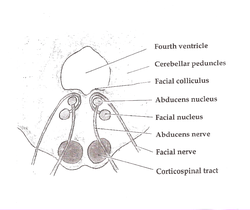| Structure affected | Effect |
|---|
| Lateral spinothalamic tract | Contralateral loss of pain and temperature from the trunk and extremities. |
| Facial nucleus & facial Nerve (CN.VII) | (1) Ipsilateral paralysis of the upper and lower face (lower motor neuron lesion). (2) Ipsilateral loss of lacrimation and reduced salivation. (3) Ipsilateral loss of taste from the anterior two-thirds of the tongue. (4) Loss of corneal reflex (efferent limb). |
| Principal sensory trigeminal nucleus and tract | Ipsilateral loss of all sensory modalities to the face (facial hemianesthesia) |
| Vestibular Nuclei and intraaxial nerve fibers | Nystagmus, nausea, vomiting, and vertigo |
| Cochlear nuclei and intraaxial nerve fibers | Hearing loss - ipsilateral central deafness |
| Middle & inferior cerebellar peduncle | Ipsilateral limb and gait ataxia |
| Descending sympathetic tract | Ipsilateral Horner's syndrome (ptosis, miosis, & anhydrosis) |
